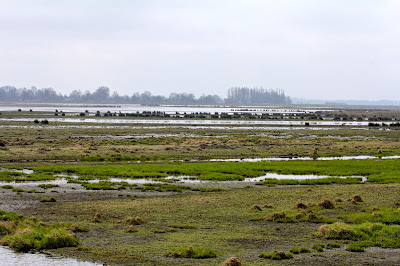The Dutch think big! Why can’t we do the same? A short trip over to The Netherlands for a
meeting with the Dutch Birdlife partner Vogelbescherming Nederland (VBN) was a
suitable excuse for a couple of site visits. First on the itinerary was a
Black-tailed Godwit hotspot at Eemland where 200+ pairs nest on a typically
open, wet meadow habitat. Godwits are
increasingly restricted to nature reserves where high water levels are
maintained and this reserve is a great example of management for meadow birds.
There are two main areas that we looked at: De Onlanden and an area near Zuidlaardermere. Flood waters are stored in these areas to various depths of up to 1m. How is this different from washlands in the UK? The key factor is there is an agreement that a level of water is retained into the spring, creating fen, reed and open water habitats. This brings a win-win situation; flood storage and wildlife-rich wetland habitat. And wow, is this a win for wildlife. 250+ pairs of Black-necked Grebes, breeding Whiskered and White-winged Black Terns, 16 booming Bitterns, Corncrake, Baillon’s, Little and Spotted Crake, 120 prs of Bluethroat, 100prs of Grasshopper Warblers and 150 prs of Marsh Warbler. But this area is not just for wildlife; it is now extensively used by local people for cycling, walking, fishing etc.
In the UK we have numerous washlands, but none deliver like De Onlanden, ours are drained down in the name of maintaining storage capacity. Why can’t we think big and imaginatively like the Dutch?





No comments:
Post a Comment